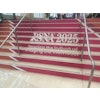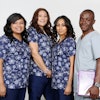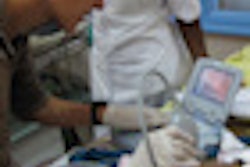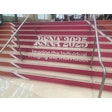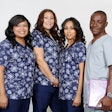University of Virginia radiologist Dr. Gia Deangelis came perilously close to being one of the casualties in last week's massive earthquake in Haiti. Deangelis was supposed to be in Port-au-Prince on January 12, the day the quake struck, and has now returned to help with the relief effort.
"I just escaped being in the earthquake because I was supposed to be in Port-au-Prince," she said in a phone interview with AuntMinnie.com a few days after the temblor struck. "I probably would have been dead."
Her story is one of a number coming from the devastated Caribbean nation that's struggling to get on its feet after the earthquake. As the world community mobilizes a massive relief effort, radiology is doing its part to ensure that quake victims have access to basic imaging technology.
Returning to Haiti
Two months ago, Deangelis spent time in the capital teaching Haitian obstetricians and midwives how to use a compact ultrasound scanner from SonoSite of Bothell, WA, that had been donated.
Deangelis, who has a background in clinical radiology and is now involved in pediatric work, has made five prior trips to work in Haitian medical facilities. She is now on her way to a rural clinic in Grison Garde, north of the decimated Port-au-Prince, to perform clinical pediatrics and physical exams. The clinic has no x-ray equipment.
Many of the patients she's treated are pregnant women with pre-eclampsia (pregnancy-induced hypertension) who have had no prenatal care. The fetus usually dies in utero, and the mothers often die of uncontrolled hemorrhages. "They often lose renal function and come in delirium or in seizure" Deangelis said. "I've never seen so many dead babies."
Of the children she's seen, many are malnourished, which is often compounded by diarrhea, or they're suffering from infected scabies. "The kids scratch themselves to death until they get a staph infection," Deangelis observed.
She also has seen a lot of fungal infections, including Tinea cruris, a pruritic superficial fungal infection of the groin and adjacent skin.
A Methodist church in Virginia has built wells in the area, so residents at least now have clean water, Deangelis said.
The main complaint of adults is peptic ulcers, caused by the Helicobacter pylori bacteria and primarily the result of their poor diet and malnutrition. "Everybody is hungry," she noted. Severely malnourished children are given fortified peanut butter.
Hospital 'pancaked'
Her colleague, Dr. William Brant, a professor of radiology at the University of Virginia in Charlottesville and a consultant to Doctors Without Borders (Médecins Sans Frontières or MSF), went to the group's three hospitals in Port-au-Prince last year to evaluate their radiology facilities, which included a plain x-ray machine and an ultrasound scanner. The equipment was "pretty old," he said, and the staff needed additional training. His assessment led to the acquisition of a new ultrasound scanner for the obstetrics hospital.
All of the hospitals were destroyed in the quake, including a four-story trauma hospital with a radiology suite and three surgical suites. "The building pancaked and wiped out everything," he said in a phone interview with AuntMinnie.com.
Doctors Without Borders is sending a portable, inflatable hospital that includes two surgical suites, four patient wards, and a medical staff to support it.
"MSF has heard that no surgical suites are left standing," Brant said. "What little they had was limited and is now gone."
The SonoSite portable unit was designed to stand up to harsh environmental conditions, including dust and extreme temperatures, the "basic definition of Haiti," he observed.
Brant said the obstetrics hospital had been "overwhelmed" by basic deliveries, which amounted to about 50 births per day. At the trauma hospital, most of the patients had sustained orthopedic injuries from falls or car accidents, he said.
The third hospital, Martissant, a community hospital, was located at the epicenter of the quake in the western part of Port-au-Prince and had treated many cases of tuberculosis, malaria, and respiratory infections.
Echoing his colleague, Brant said the most pervasive problem was widespread severe malnutrition. "There were whole wards of malnourished children."
Mobilizing to help
As the world community mobilizes to help the stricken country, radiology is part of the response.
Dr. Pablo Jiménez, regional advisor in radiological health for the Pan American Health Organization (PAHO) and the World Health Organization (WHO), said a team of 12 specialists including public health experts, engineers, epidemiologists, and specialists in communicable disease and trauma care have arrived in Haiti to assess needs.
"The health service systems have been destroyed," he said in a phone interview with AuntMinnie.com. "Medical teams will need [radiology] images to make decisions regarding the patients' injuries."
Some 10 years ago, his group developed the World Health Imaging System for Radiology (WHIS-RAD) program that provided basic x-ray equipment donated by GE Healthcare (Chalfont St. Giles, U.K.) and Philips Healthcare (Andover, MA) to Port-au-Prince hospitals.
"We know this equipment may have been destroyed or is not functioning," Jiménez said. "The need in radiology will be huge, particularly for trauma needs," he noted.
International relief funding has poured in, Jiménez says.
"We have the money, but we need to know how to expedite supplies and assess the needs," he explained. "And we don't know what vendors' abilities are to deliver the necessary equipment. Requests have been sent to imaging vendors to see how soon they can deliver equipment.
"This is a very special situation in the sense that so much of the infrastructure has collapsed; all basic services have collapsed," Jiménez observed. "We don't know the capacity to generate electricity in the few facilities that are providing some care."
Numerous charities are currently active in Haiti and are helping with relief efforts. For a comprehensive list, click here.
By Donna Domino
AuntMinnie.com contributing writer
January 19, 2010
Related Reading
Nyaya Health brings ultrasound expertise to Nepal, June 25, 2009
Digital technology sparks revival of global x-ray project, April 15, 2009
All hands on deck: How radiological staff can help on hospital ships, November 21, 2006
Radiology rises to the occasion for Katrina survivors and victims, December 27, 2005
Copyright © 2010 AuntMinnie.com
